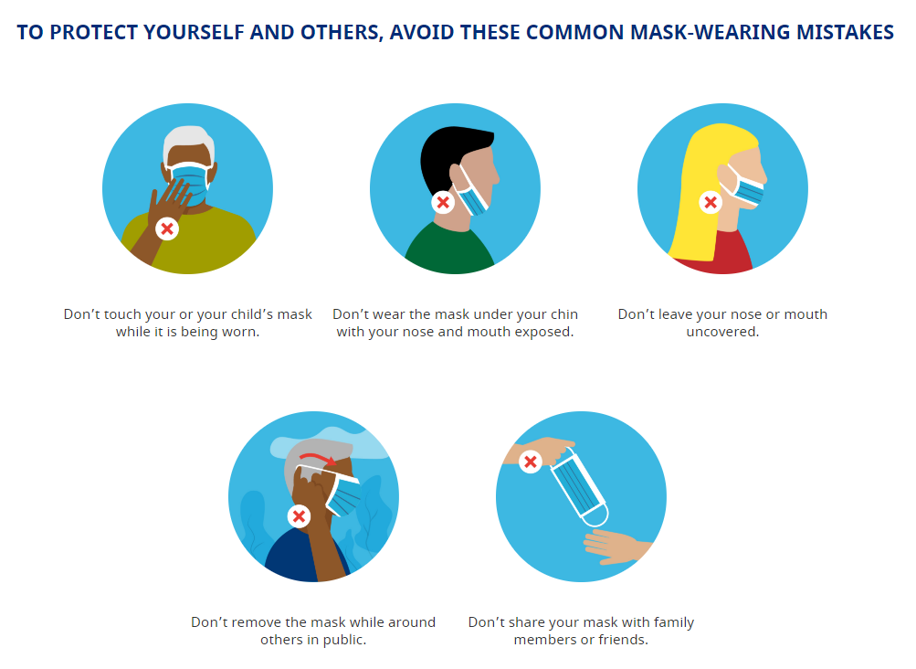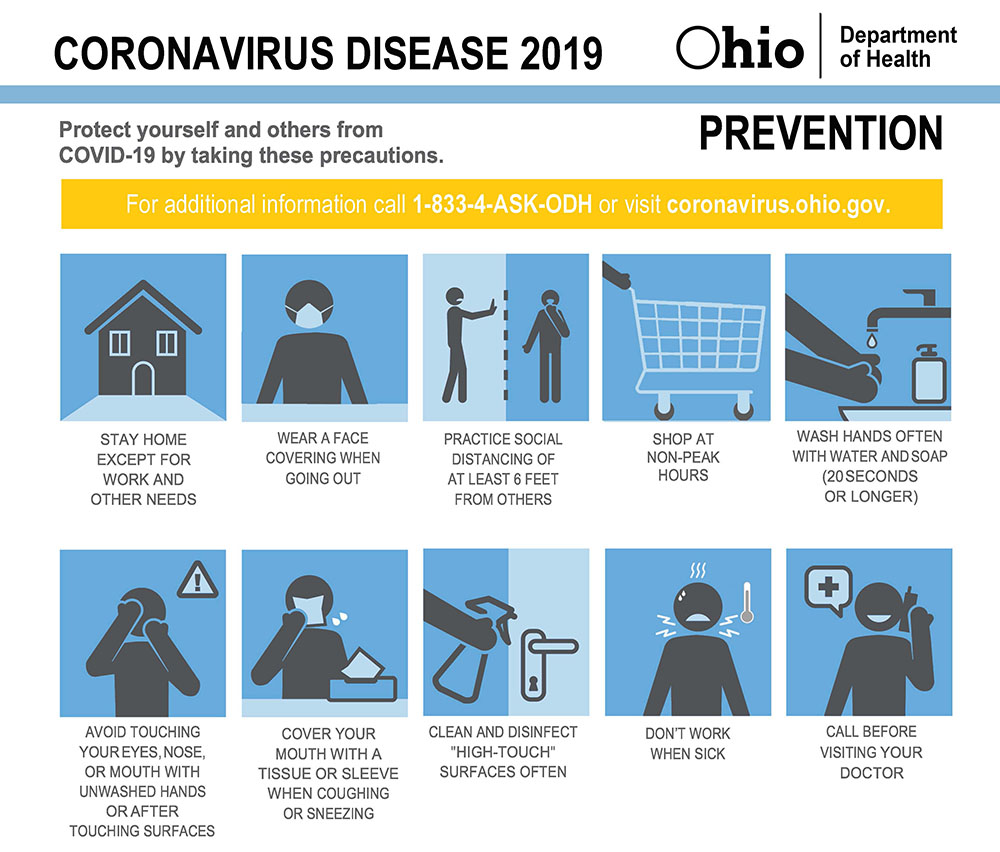What is Coronavirus Disease 2019?
- Coronavirus disease 2019 (COVID-19) is a respiratory illness that can spread from person to person. It is a virus and spreads like the flu.
- The situation regarding the COVID-19 pandemic is rapidly changing. For the most up-to-date information, please visit the following resources:
- Read Myths & Facts about COVID-19 from the CDC
COVID-19: Situation In Trumbull County & Ohio
- The most up-to-date COVID-19 information and case data in Trumbull County can be found at Trumbull County Combined Health District
- Click here for the most recent update from the Ohio Department of Health (ODH).
- Questions about the vaccine? Check out the COVID-19 Vaccine Fact Sheet.
UPDATES FOR THOSE WHO ARE unVACCINATED
- Click here for CDC guidance related to safely participating in indoor and outdoor activities for folks who are unvaccinated.
- Nervous about the side effects you may experience after being vaccinated? Here is some information from the CDC about possible side effects and helpful tips for mitigating them.
- Pregnant or breastfeeding and not sure whether getting vaccinated is right for you? The CDC has guidance about COVID-19 vaccines while pregnant or breastfeeding.
- Safe and effective: the best way to stay safe from COVID-19 is to get vaccinated. Read more to learn about the safety of the available COVID-19 vaccines.
I’ve Received My Vaccine – Now What?
The CDC is providing updated guidance for folks who have been fully vaccinated (two doses of Moderna or Pfizer vaccines, or one dose of Johnson & Johnson vaccine). To learn more about what’s changed, what hasn’t changed, and more, check out these updates from the CDC.
Live Well Trumbull is encouraging everyone who receives a COVID-19 vaccine to enroll in V-safe. This is a smartphone tool you can use to tell CDC if you have any side effects after vaccination. If you report serious side effects, someone from CDC will call to follow up. Find out more about v-safe here:
How does COVID-19 spread?
- When someone who has COVID-19 coughs or exhales, they release droplets of infected fluid. Most of these droplets fall on nearby surfaces and objects such as desks, tables, or telephones. People could catch COVID-19 by touching contaminated surfaces or objects and then touching their eyes, nose, or mouth.
- If a person is standing within 3 feet of a person with COVID-19 when they cough or sneeze, they can catch it by breathing in droplets coughed out or exhaled by the infected person. Basically, COVID-19 spreads in a similar way to flu.
- Wearing a face mask, properly, in public is therefore the best thing we can all do to protect ourselves and each other.

Supplemental Resource: https://www.cdc.gov/coronavirus/2019-ncov/downloads/cloth-face-covering.pdf
cases of COVID-19 in the U.S.
- The first U.S. case was reported January 21, 2020. The most current information, updated daily at noon EST. can be found here: https://www.cdc.gov/coronavirus/2019-ncov/cases-in-us.html
- Over 180 countries have reported laboratory-confirmed cases of COVID19 according to the World Health Organization. The most current global information can be found here: https://www.who.int/emergencies/diseases/novel-coronavirus-2019/situation-reports
What are the symptoms of COVID-19?
- People with COVID-19 have had a wide range of symptoms reported – including most commonly, but not limited to:
- Fever or chills
- Cough
- Shortness of breath or difficulty breathing
- Other symptoms may include:
- Fatigue
- Muscle or body aches
- Headache
- New loss of taste or smell
- Sore throat
- Congestion or runny nose
- Indigestion
- Nausea or vomiting
- Diarrhea
- Most persons infected with COVID-19 experience mild symptoms and recover. However, some go on to experience more serious illness and may require hospital care.
- In rare cases, COVID-19 can lead to severe respiratory problems, kidney failure or death.
Who is at risk of contracting COVID-19?
- Risk of serious illness rises with age: people over 40 seem to be more vulnerable than those under 40.
- People with weakened immune systems and people with conditions such as diabetes, heart and lung disease are also more vulnerable to serious illness.
What are some preventive actions you can take to help prevent the spread of all respiratory diseases?
- Avoid close contact with people who are sick.
- Avoid touching your eyes, nose, and mouth.
- Stay home when you are sick.
- Cover your cough or sneeze with a tissue, then throw the tissue in the trash.
- Clean and disinfect frequently touched objects and surfaces using a regular household cleaning spray or wipe.
- Follow CDC’s recommendations for using a facemask:
- CDC recommends that everyone should wear a facemask to protect themselves from COVID-19.
- Wash your hands often with soap and water for at least 20 seconds, especially after going to the bathroom; before eating; and after blowing your nose, coughing, or sneezing.
- If soap and water are not readily available, use an alcohol-based hand sanitizer with at least 60% alcohol.
How worried should we be about COVID-19?
- That’s a complicated question for two reasons
- First, while global knowledge of COVID-19 is increasing every day, much remains unknown. Many cases are thought to be mild or asymptomatic, making it hard to know how wide the virus has spread or how deadly it is
- Second, much of the risk comes not from the virus itself but from how it affects the societies it hits. Examples include:
- People not being able to go to work and school to reduce the risk of spreading the disease
- Negative impact on the stock market
- Overwhelming hospitals and the health care system
- The most important thing is for all of us to remember and follow the guidelines to prevent the spread of all respiratory diseases
- Avoid close contact with people who are sick.
- Avoid touching your eyes, nose, and mouth.
- Stay home when you are sick.
- COVID-19 testing is now open in Ohio to anyone who would like to be tested, including those who are low-risk or not showing symptoms. Anyone who would like a test should speak with their healthcare provider or contact a testing location to arrange a test. Click here to view an interactive map of testing locations.


